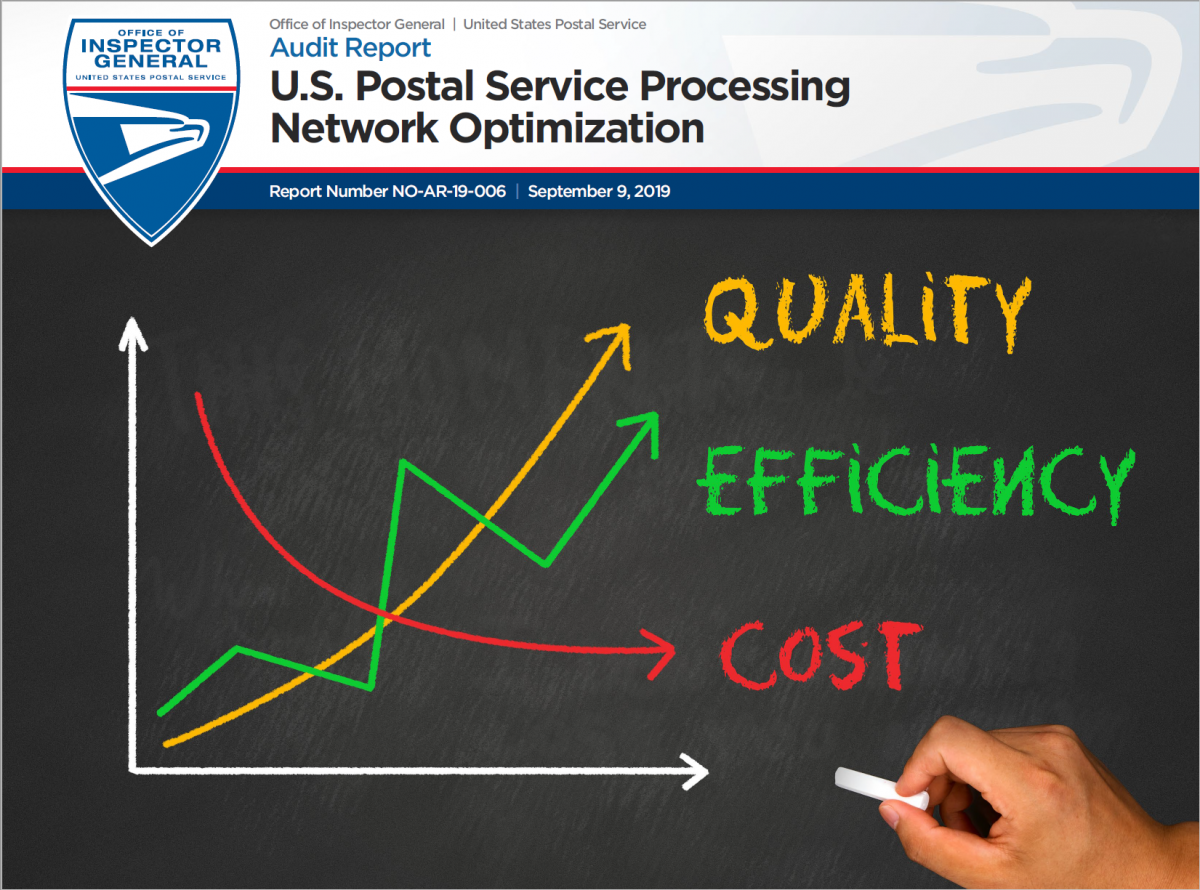Objective
Our objective was to evaluate trends and practices the U.S. Postal Service uses to optimize its processing network.
The Postal Service’s processing network includes 285 facilities that processed 301 billion pieces of mail in fiscal year (FY) 2018, with an average staffing complement of 82,065. These facilities are responsible for processing mail for delivery to 159 million addresses.
As labor costs are 80 percent of the Postal Service’s budget, it is important to manage personnel expenses. The Postal Service uses total operating expense and mail processing productivity (mailpieces processed per workhour) to manage costs. They also use the Function 1 (F1) Scheduler tool to establish staffing levels at plants.
Further, the Postal Service has implemented strategic initiatives to optimize the processing network. Specifically, the goal of the Ready Now → Future Ready Optimize Network Platform initiative was to help evaluate, right size, and equip the processing network to increase operating efficiency and reduce costs.
Additionally, the Operational Window Change (OWC) revised First-Class Mail service standards in January 2015. The initiative was intended to help align network processing capacity – processing machines and people – with declining mail volume and allow for more time to process certain types of mail. The Postal Service also eliminated excess mail processing capacity and plants through consolidations. Management calculated planned costs savings from plant consolidations by completing Area Mail Processing (AMP) feasibility studies. However, consolidations were suspended in FY 2015 due to operational considerations.
What the OIG Found
The Postal Service has not decreased mail processing costs at a rate consistent with the decline in mail volume. Mail processing workhours have not decreased since FY 2014, while overtime and penalty overtime workhours have increased significantly. As a result, the Postal Service is processing mail with lower productivity for manual, flats, and letters. Reducing mail processing costs and workhours is critical at a time when mail volume is declining.
Processing Costs
From FY 2014 to 2018, mail processing costs increased by $301.3 million (or 4 percent). When adjusted for inflation, mail processing costs decreased by 2 percent. However, processed mail volume decreased by 9 percent (or 31 billion mailpieces).
In FY 2017, the Postal Service was able to decrease mail processing costs by $6.9 million, but mail processing costs the following year, in FY 2018, increased by $37.4 million. This volatility in costs was especially apparent in mail processing overtime and penalty overtime. In FY 2017, overtime and penalty overtime costs decreased by $105.8 million but in FY 2018, these costs increased by $256.9 million.
From FY 2014 to 2018, mail processing workhours increased by 11,987 (or 0.01 percent). The Pacific Area experienced the largest increase in mail processing workhours (5 percent) while the Eastern Area had the largest decrease (3 percent).
In a prior audit report, we recommended the Postal Service develop and implement annual tracking methodologies for any significant projected operational costs or savings and use a sensitivity analysis to account for such impacts as changes in mail volume and labor and transportation costs.
We plan to conduct additional audit work related to mail processing network efficiency and assess efforts to standardize operations.
What the OIG Recommended
We recommended management:
- Develop a plan to reduce costs and improve the number of managers at plants achieving their total operating expense goal.
- Utilize lessons learned and best practices from the significant increase in parcel productivity to develop a plan to increase productivity for manual, flats, and letter processing.
- Revise and update AMP feasibility studies to determine whether cost savings could be realized and consolidations should continue.
Read full report
Source: USPS Office of Inspector General

